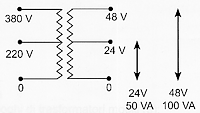
Macchina statica funzionante in corrente alternata con 2 o più avvolgimenti che, con il principio della variazione del flusso nel tempo, trasforma a pari frequenza un sistema di differenti valori con lo scopo di trasmettere potenza elettrica.
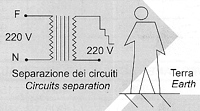
Trasformatore in cui gli avvolgimenti primari e secondari sono separati elettricamente da un isolamento doppio o rinforzato per limitare, nel circuito alimentato dall’avvolgimento secondario, rischi dovuti a contatti accidentali simultanei con la terra e con parti attive o masse che possono andare in tensione in caso di guasto all’isolamento fondamentale.
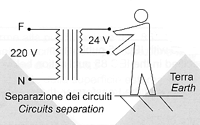
Trasformatore di isolamento destinato ad alimentare circuiti a bassissima tensione di sicurezza (<= 50 Volt a vuoto). Il contatto accidentale sulle 2 fasi dell'avvolgimento secondario può essere sopportato senza alcun pericolo per l'uomo. In funzione della protezione contro i contatti diretti e indiretti viene definita la classe di isolamento di un trasformatore (la classificazione non si riferisce al sistema di isolamento tra avvolgimenti primari e secondari).
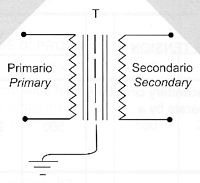
L’utilizzo di trasformatori per l’alimentazione di apparecchiature sofisticate (elettroniche e informatiche), l’impiego di trasformatori in ambienti medicali dove i pericoli per i pazienti devono essere ridotti al minimo, richiedono la presenza di uno schermo elettrostatico posizionato tra l’avvolgimento primario e il secondario. Lo schermo elettrostatico, costituito da 1 spira di rame o da un avvolgimento aperti e isolati, scarica a terra i disturbi presenti sulla rete primaria (correnti parassite) ed evita che questi si ritrovino sul circuito secondario (utilizzatore). I trasformatori per utilizzo in ambienti medicali sono realizzati con questo accorgimento.
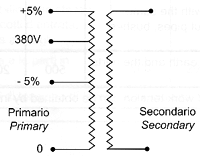
I trasformatori con prese di regolazione sull’avvolgimento primario +-5% (per avvolgimenti monotensione) e +-15 volt (per avvolgimenti bitensione), consentono di compensare particolari variazioni di rete, cadute di tensione nei conduttori di alimentazione o aumenti di tensione sul secondario quando il trasformatore lavora a carico ridotto.

Tutte le parti metalliche accessibili del trasformatore sono separate dalle parti in tensione tramite l’isolamento fondamentale. Inoltre le parti metalliche accessibili devono essere collegate tramite un morsetto di terra a un conduttore di protezione (facente parte dell’impianto elettrico dell’installazione).

Tutte le parti metalliche accessibili del trasformatore sono separate dalle parti in tensione mediante un isolamento doppio o rinforzato. Il trasformatore non deve essere collegato a terra.
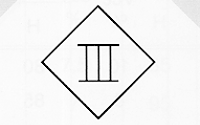
La protezione contro i contatti diretti e indiretti si basa sulla bassissima tensione di sicurezza (<=50Volt) da garantire per entrambi gli avvolgimenti del trasformatore (primari e secondari). Un trasformatore di classe 3 non deve avere il morsetto di terra.
Trasformatore che è previsto per essere protetto contro un eccessivo aumento della sua temperatura tramite un dispositivo di protezione non fornito con il trasformatore stesso.
Trasformatore la cui temperatura in caso di sovraccarico o di cortocircuito non supera i limiti previsti. La resistenza al corto circuito può essere ottenuta con o senza dispositivi di protezione incorporati (“non per costruzione” e “per costruzione”).
